Measuring the Inequalities in the Distribution of Public Healthcare Resources by the HRDI (Health Resources Density Index): Data Analysis from 2010 to 2019
Abstract
:1. Introduction
2. Materials and Methods
2.1. Data Sources and Setting
2.2. Statistical Analysis
3. Results
3.1. The Results of the HRDI
3.2. A Comparison with Requirements of the Government
4. Discussion
5. Conclusions
Author Contributions
Funding
Institutional Review Board Statement
Informed Consent Statement
Data Availability Statement
Conflicts of Interest
References
- Toyabe, S.-I. Trend in geographic distribution of physicians in Japan. Int. J. Equity Health 2009, 8, 5. [Google Scholar] [CrossRef] [PubMed] [Green Version]
- Sousa, A.; Dal Poz, M.R.; Carvalho, C.L. Monitoring inequalities in the health workforce: The case study of Brazil 1991–2005. PLoS ONE 2012, 7, e33399. [Google Scholar] [CrossRef] [Green Version]
- Murray, C.J.; Frenk, J.; Evans, T. The Global Campaign for the Health MDGs: Challenges, opportunities, and the imperative of shared learning. Lancet 2007, 370, 1018–1020. [Google Scholar] [CrossRef]
- Woldemichael, A.; Takian, A.; Sari, A.A.; Olyaeemanesh, A. Inequalities in healthcare resources and outcomes threatening sustainable health development in Ethiopia: Panel data analysis. BMJ Open 2019, 9, e022923. [Google Scholar] [CrossRef] [Green Version]
- Whitehead, M. The concepts and principles of equity and health. Health Promot. Int. 1991, 6, 217–228. [Google Scholar] [CrossRef]
- O’Donnell, O.; Propper, C. Equity and the distribution of UK National Health Service resources. J. Health Econ. 1991, 10, 1–19. [Google Scholar] [CrossRef]
- Braveman, P. Defining equity in health. J. Epidemiol. Community Health 2003, 57, 254–258. [Google Scholar] [CrossRef]
- Zhang, Y.; Wang, Q.; Jiang, T.; Wang, J. Equity and efficiency of primary health care resource allocation in mainland China. Int. J. Equity Health 2018, 17, 140. [Google Scholar] [CrossRef] [Green Version]
- Wiseman, V.; Lagarde, M.; Batura, N.; Lin, S.; Irava, W.; Roberts, G. Measuring inequalities in the distribution of the Fiji Health Workforce. Int. J. Equity Health 2017, 16, 115. [Google Scholar] [CrossRef] [Green Version]
- Hanvoravongchai, P.; Chavez, I.; Rudge, J.W.; Touch, S.; Putthasri, W.; Chau, P.; Phommasack, B.; Singhasivanon, P.; Coker, R.; the AsiaFluCap Project Consortium. An analysis of health system resources in relation to pandemic response capacity in the Greater Mekong subregion. Int. J. Health Geogr. 2012, 11, 53. [Google Scholar] [CrossRef] [Green Version]
- Xu, K.; Zhang, K.; Wang, D.; Zhou, L. Trend in distribution of primary health care professionals in Jiangsu Province of eastern China. Int. J. Equity Health 2014, 13, 117. [Google Scholar] [CrossRef] [Green Version]
- Li, Z.; Yang, L.; Tang, S.; Bian, Y. Equity and Efficiency of Health Resource Allocation of Chinese Medicine in Mainland China: 2013–2017. Front. Public Health 2020, 8, 579269. [Google Scholar] [CrossRef]
- Cao, X.; Bai, G.; Cao, C.; Zhou, Y.; Xiong, X.; Huang, J.; Luo, L. Comparing Regional Distribution Equity among Doctors in China before and after the 2009 Medical reform policy: A data analysis from 2002 to 2017. Int. J. Environ. Res. Public Health 2020, 17, 1520. [Google Scholar] [CrossRef] [PubMed] [Green Version]
- Yang, Y.; Morii, Y.; Fujiwara, K.; Ishikawa, T.; Yamashina, H.; Suzuki, T.; Nakaya, J.; Ogasawara, K. Trend of Gini coefficient of healthcare resources in China from 1998 to 2016. J. Hosp. Manag. Health Policy 2021, 5, 40. [Google Scholar] [CrossRef]
- Yao, H.; Zhan, C.; Sha, X. Current situation and distribution equality of public health resource in China. Arch. Public Health 2020, 78, 86. [Google Scholar] [CrossRef]
- Li, Y.; Zhang, Y.; Fang, S.; Liu, S.; Liu, X.; Li, M.; Liang, H.; Fu, H. Analysis of inequality in maternal and child health outcomes and mortality from 2000 to 2013 in China. Int. J. Equity Health 2017, 16, 66. [Google Scholar] [CrossRef] [PubMed] [Green Version]
- Li, Q.; Wei, J.; Jiang, F.; Zhou, G.; Jiang, R.; Chen, M.; Zhang, X.; Hu, W. Equity and efficiency of health care resource allocation in Jiangsu Province, China. Int. J. Equity Health 2020, 19, 211. [Google Scholar] [CrossRef]
- Cai, W.; Li, C.; Sun, M.; Hao, M. Measuring inequalities in the public health workforce at county-level centers for Disease Control and Prevention in China. Int. J. Equity Health 2019, 18, 179. [Google Scholar] [CrossRef] [Green Version]
- Fang, Y.; Si, L. A study on effectiveness of health care institution services by the healthcare resource density index. J. Sichuan Prov. Health Manag. Cadre Coll. 2000, 19, 209–210. (In Chinese) [Google Scholar]
- Zhu, B.; Hsieh, C.W.; Zhang, Y. Incorporating spatial statistics into examining equity in health workforce distribution: An empirical analysis in the Chinese context. Int. J. Environ. Res. Public Health 2018, 15, 1309. [Google Scholar] [CrossRef] [Green Version]
- Tao, Y.; Henry, K.; Zou, Q.; Zhong, X. Methods for measuring horizontal equity in health resource allocation: A comparative study. Health Econ. Rev. 2014, 4, 10. [Google Scholar] [CrossRef] [PubMed] [Green Version]
- Yang, D. The Notice of the General Office of the State Council on Issuing the Outline for the Planning of the National Medical and Health Service system (2015–2020). J. Tradit. Chin. Med. Manag. 2015, 7, 99. (In Chinese) [Google Scholar]
- Fang, Y.; Si, L.; Zheng, X.; Li, M.; Liu, S.; Zhang, R. Study on the health resource density index, China. Health Manag. 2000, 4, 253–254. [Google Scholar]
- Wei, H.; Fang, R.; Zhang, T.; Wang, W.Y. The utilization of online medical resources and the influencing factors. In Proceedings of the International Conference on Digital Health and Medical Analytics, Beijing, China, 24–25 July 2020; Springer: Singapore, 2020; pp. 66–74. [Google Scholar]
- Wu, J.; Zhou, L. The trans-regional flow of medical information resource: The study of online health communities’ role in optimizing allocation of medical resource. J. Inf. Resour. Manag. 2017, 7, 58–65. [Google Scholar]
- Liang, J.; Pengqian, F. Study on the configuration Fairness and utilization efficiency of Inter-provincial Health Resource in China. Chin. Health Econ. 2013, 32, 60–62. (In Chinese) [Google Scholar]
- Xiaohua, Z. Research on the evaluation indicators of health resources in ethnic areas. Health Soft Sci. 1993, 11–35. [Google Scholar]
- Xiaoyan, S. 2021 Interpretation of GDP data in China. Zheshang 2022, 77, 848. [Google Scholar]
- Ministry of Emergency Management. Li Keqiang Presided over an Executive Meeting of the State Council to Listen to Reports on the Progress of the Comprehensive Reform of Public Hospitals and the Construction of Medical Complexes and Required to Deepen the Medical Reform and Optimize the Allocation of Resources to Ensure People’s Health Deployment. Benefit the People; Ministry of Emergency Management: Beijing, China, 2017; p. 22.
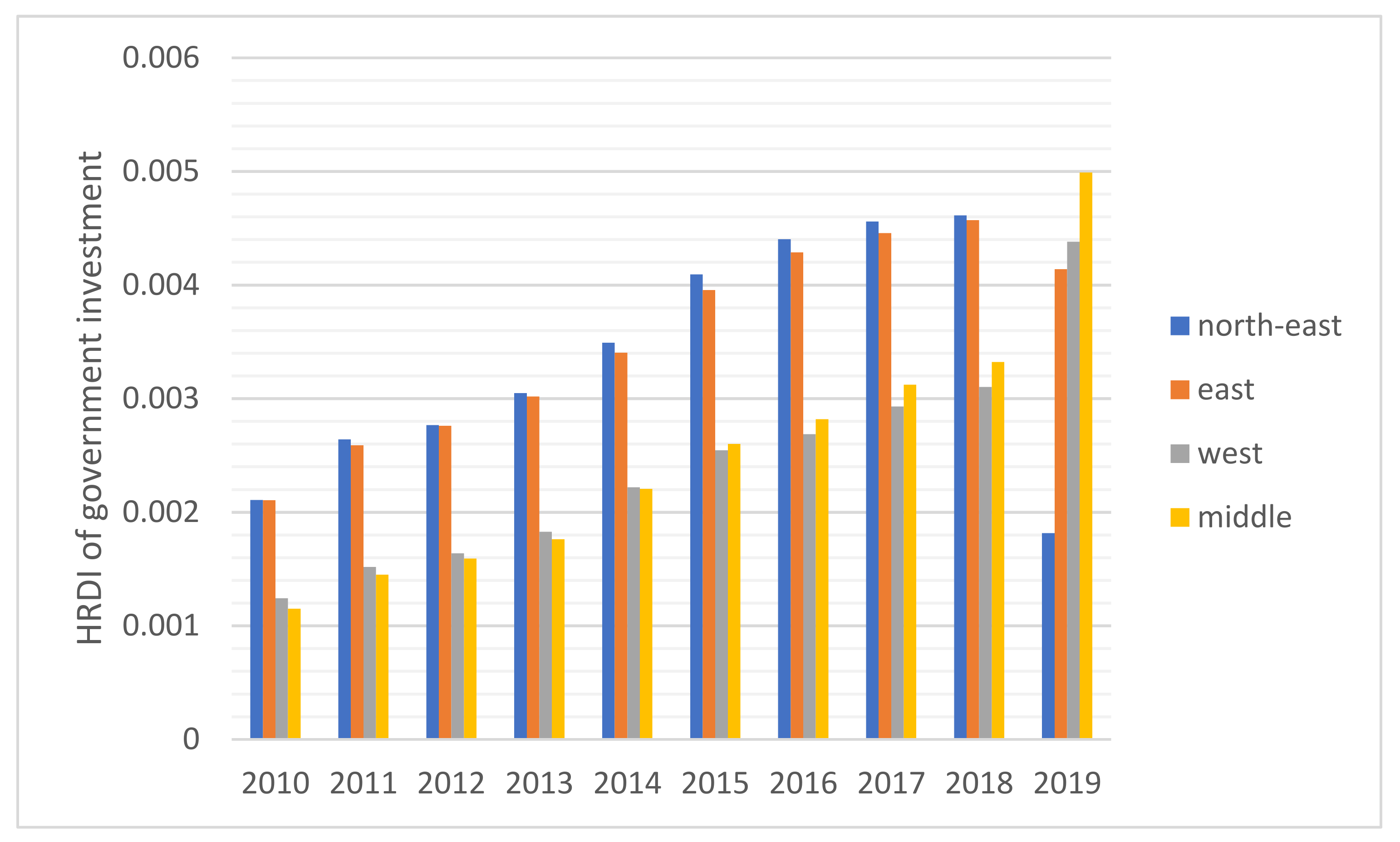
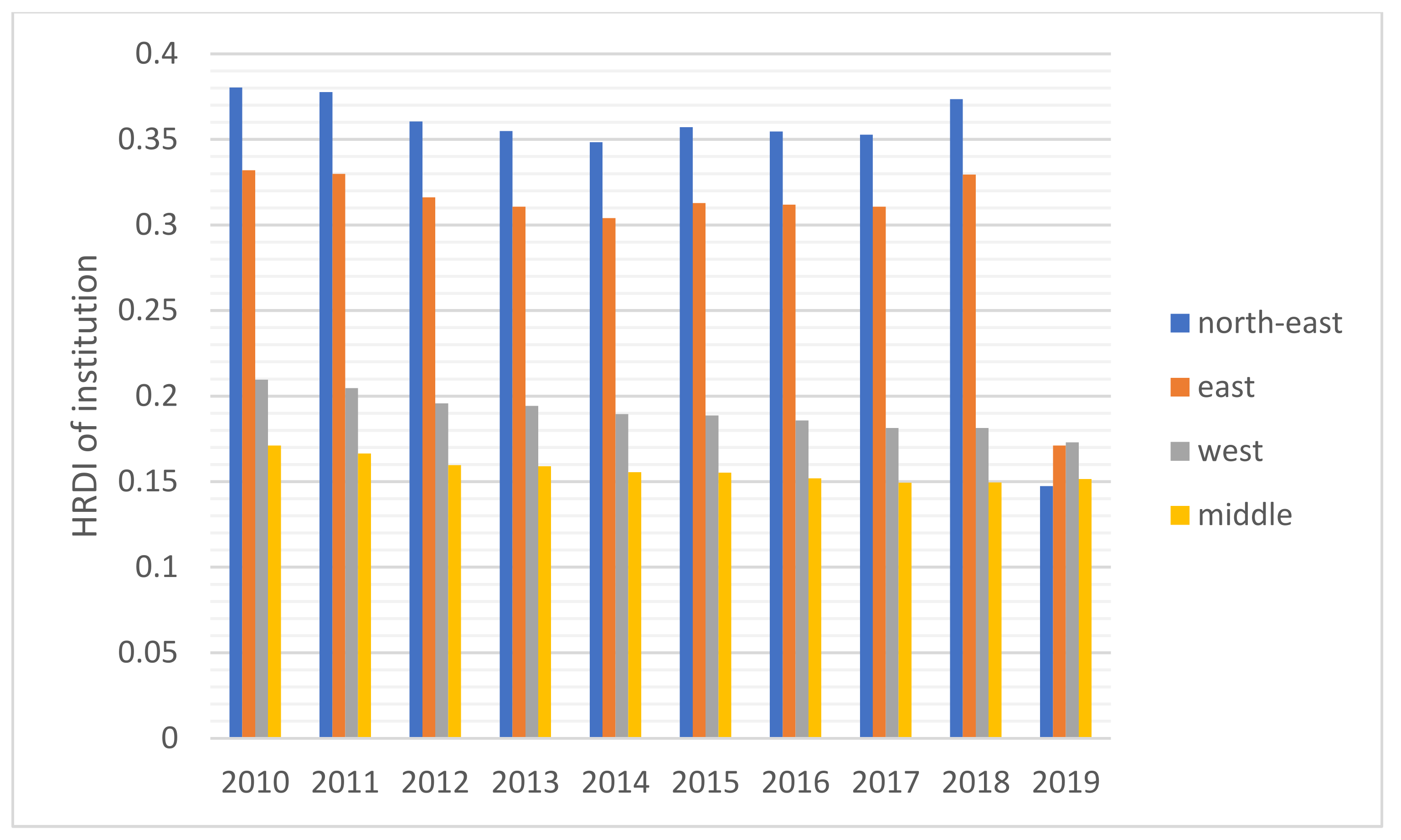
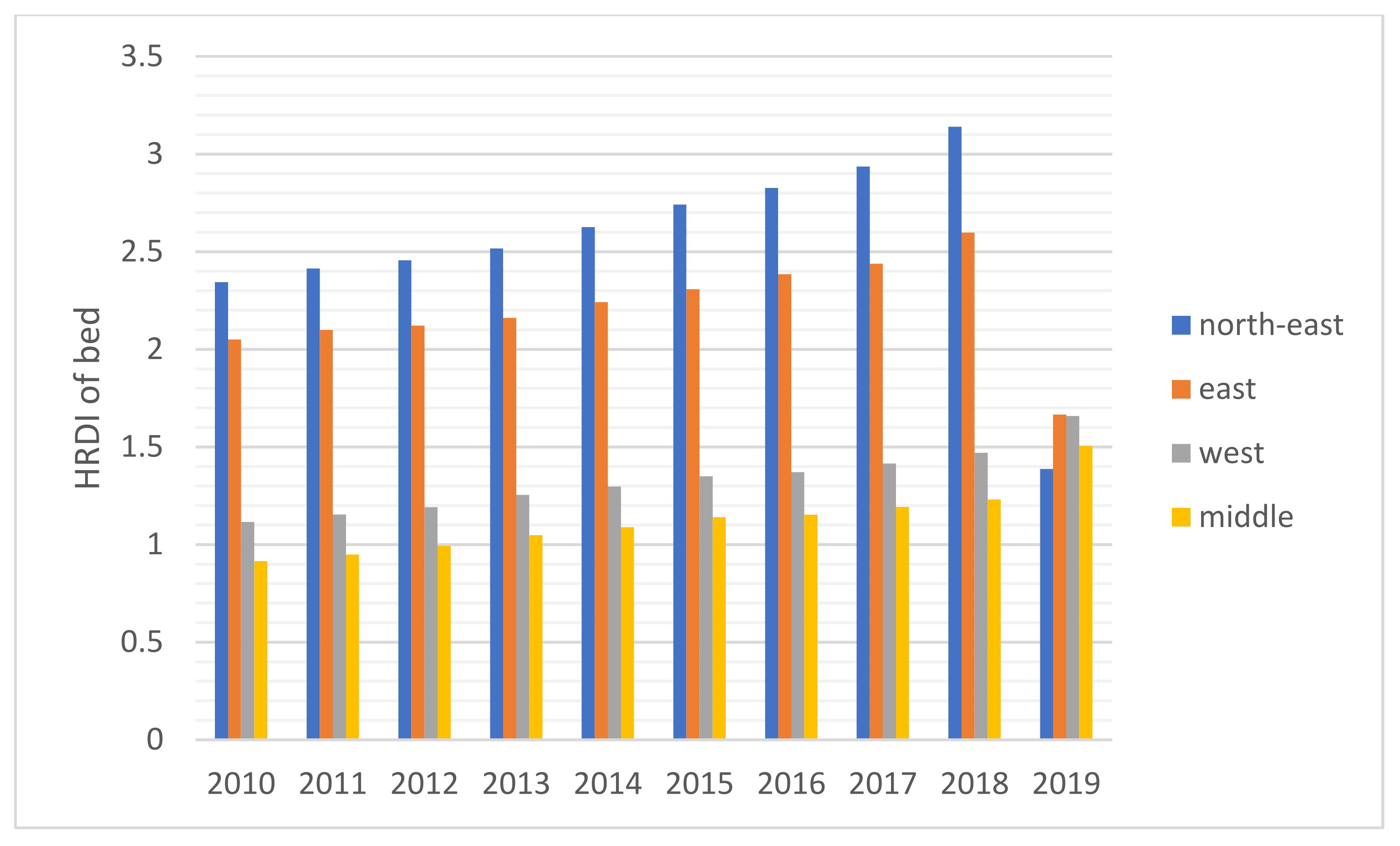
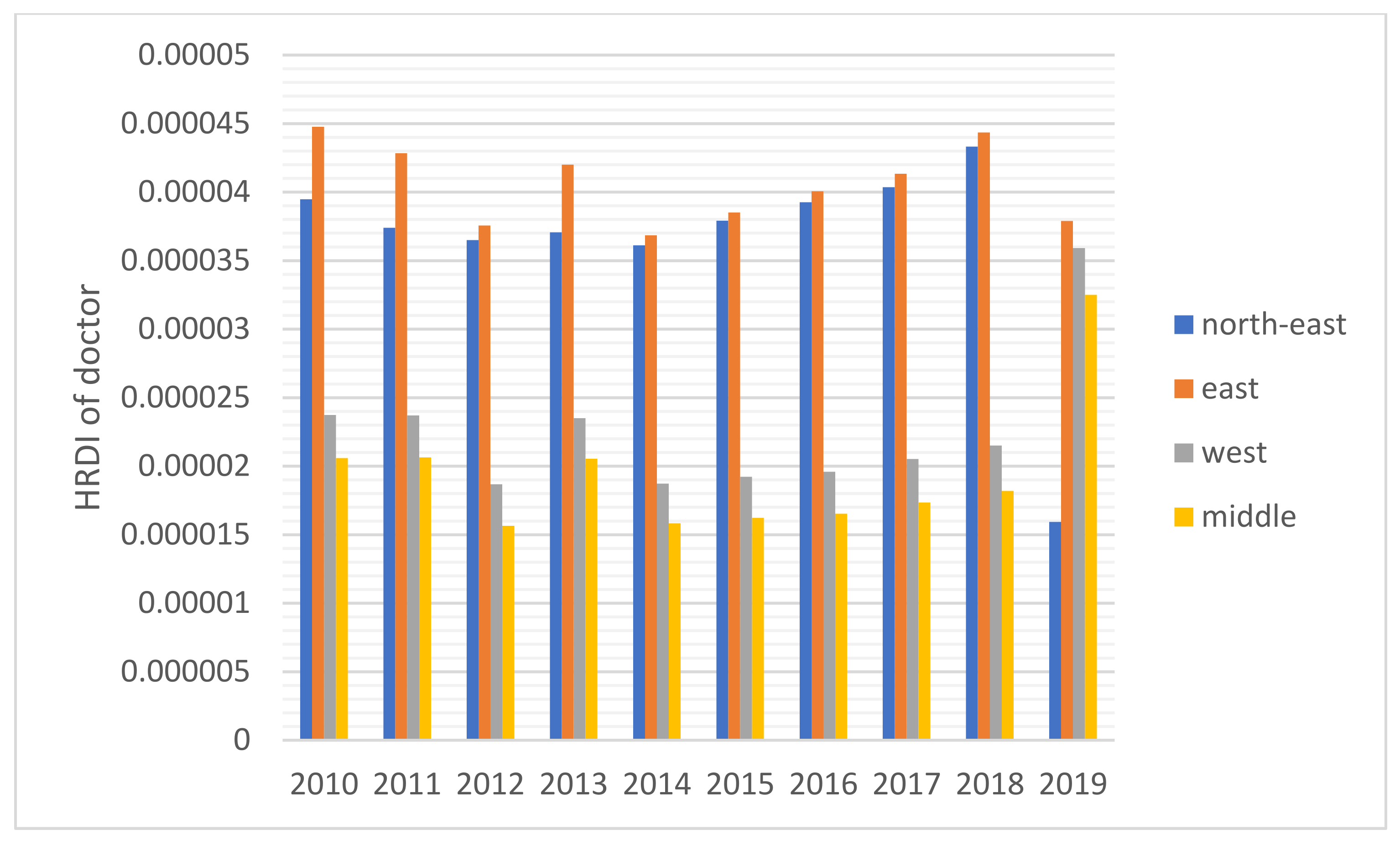
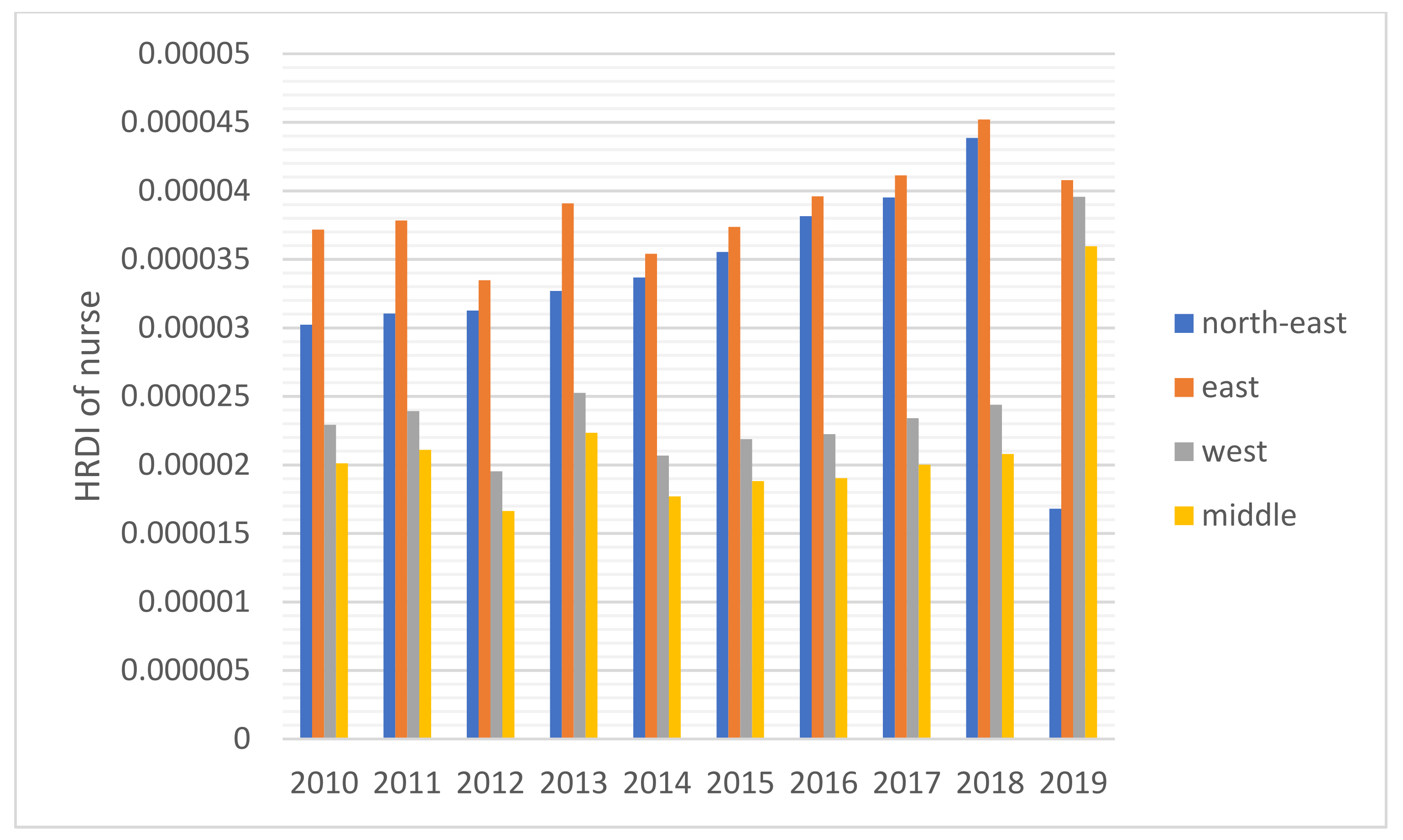
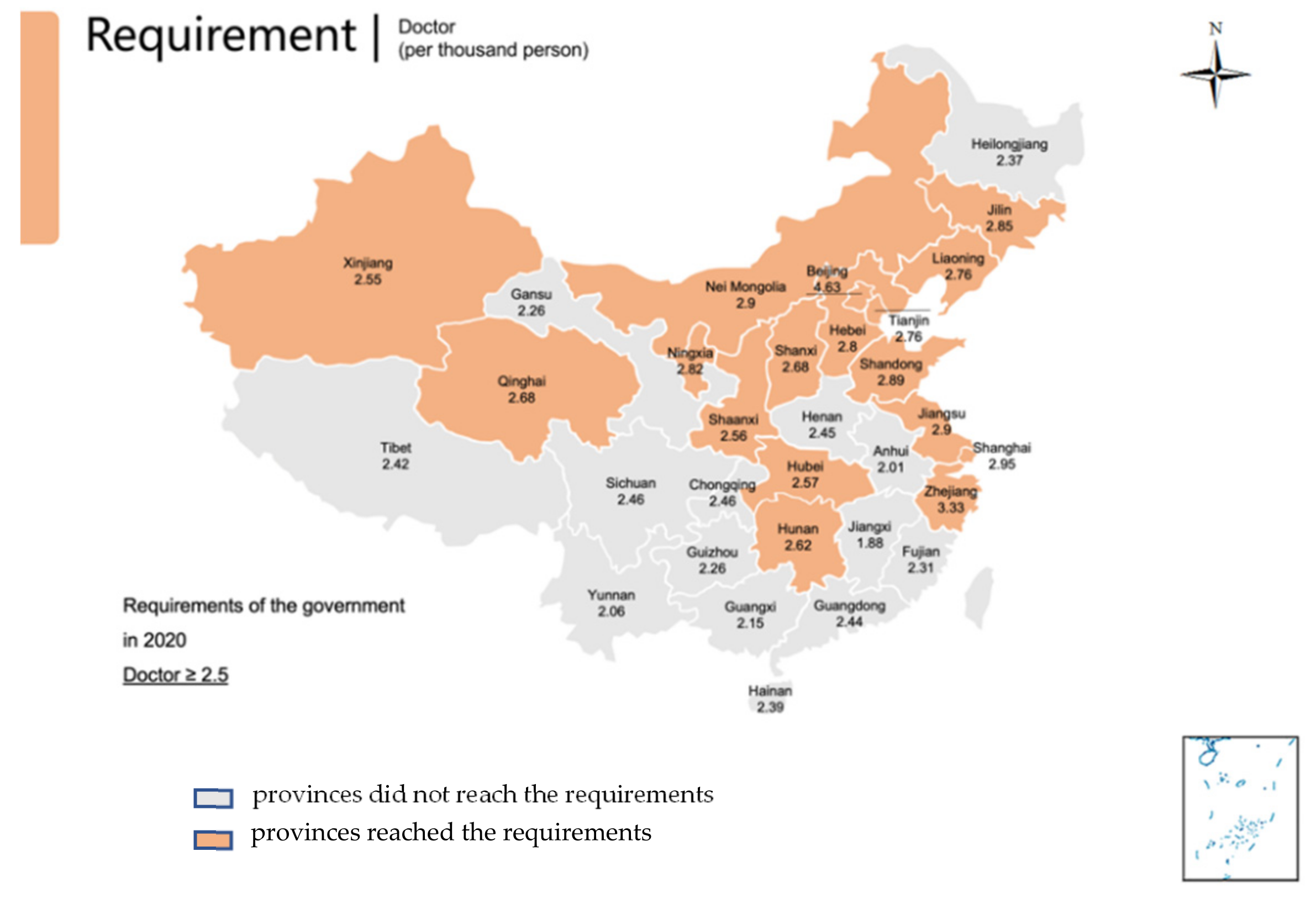
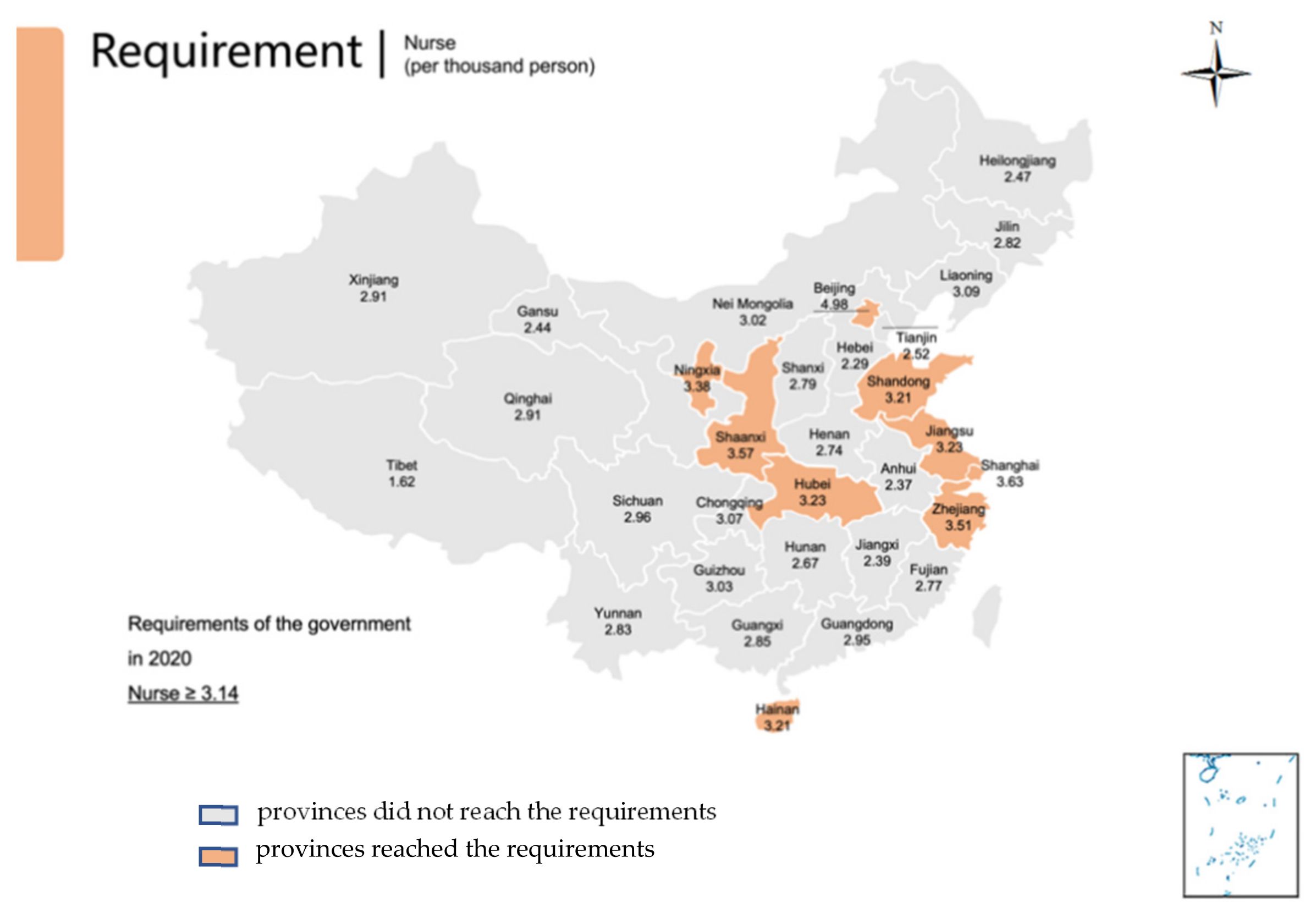
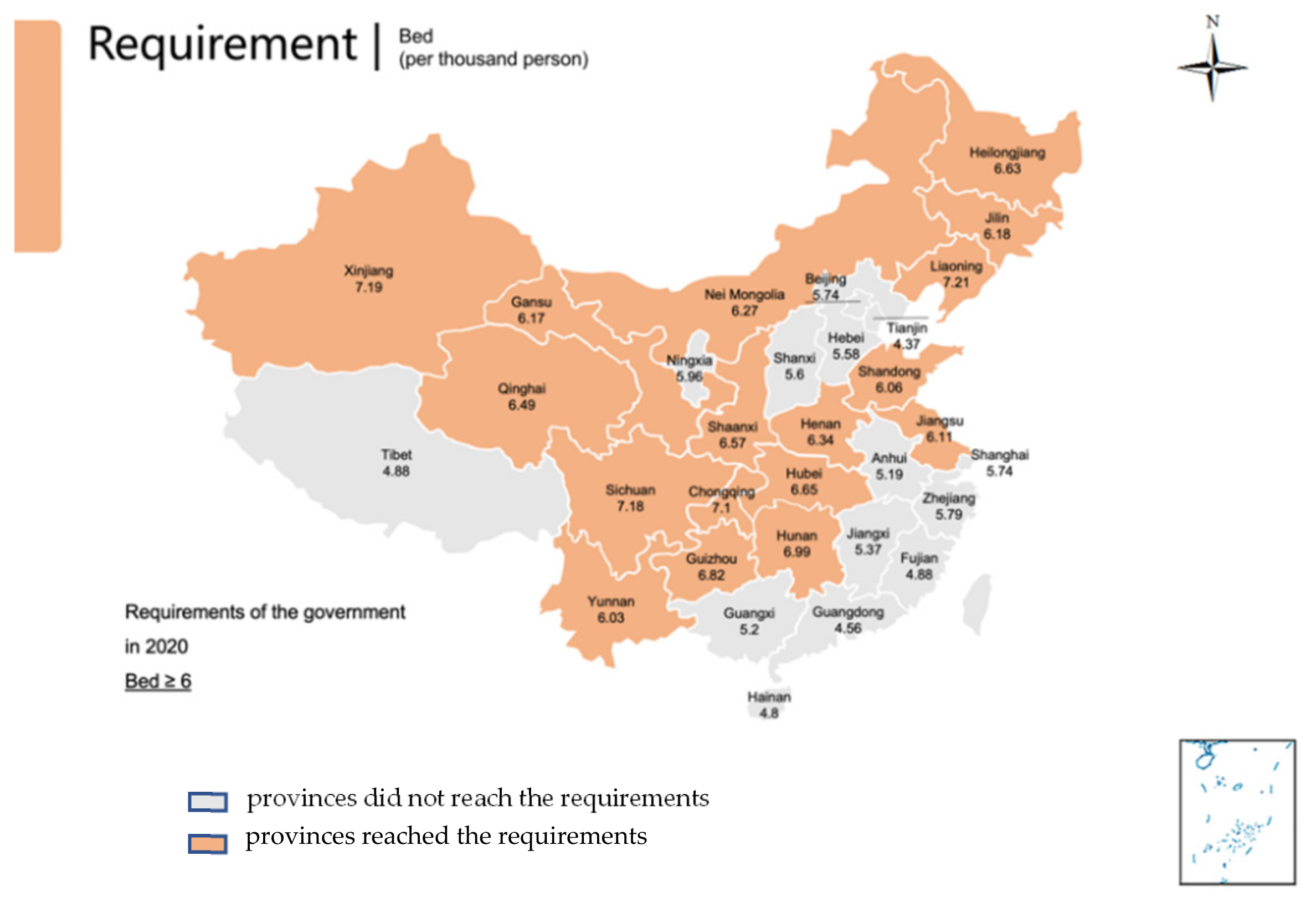
| Area | Province | Doctor (per Thousand Person) | Nurse (per Thousand Person) | Bed (per Thousand Person) |
|---|---|---|---|---|
| North-east | Liaoning | 2.76 | 3.09 | 7.21 |
| North-east | Jilin | 2.85 | 2.82 | 6.18 |
| North-east | Heilongjiang | 2.37 | 2.47 | 6.63 |
| East | Beijing | 4.63 | 4.98 | 5.74 |
| East | Tianjin | 2.76 | 2.52 | 4.37 |
| East | Hebei | 2.8 | 2.29 | 5.58 |
| East | Shanghai | 2.95 | 3.63 | 5.74 |
| East | Jiangsu | 2.9 | 3.23 | 6.11 |
| East | Zhejiang | 3.33 | 3.51 | 5.79 |
| East | Fujian | 2.31 | 2.77 | 4.88 |
| East | Shandong | 2.89 | 3.21 | 6.06 |
| East | Guangdong | 2.44 | 2.95 | 4.56 |
| East | Hainan | 2.39 | 3.21 | 4.8 |
| West | Nei Mongolia | 2.9 | 3.02 | 6.27 |
| West | Guangxi | 2.15 | 2.85 | 5.2 |
| West | Chongqing | 2.46 | 3.07 | 7.1 |
| West | Sichuan | 2.46 | 2.96 | 7.18 |
| West | Guizhou | 2.26 | 3.03 | 6.82 |
| West | Yunnan | 2.06 | 2.83 | 6.03 |
| West | Tibet | 2.42 | 1.62 | 4.88 |
| West | Shaanxi | 2.56 | 3.57 | 6.57 |
| West | Gansu | 2.26 | 2.44 | 6.17 |
| West | Qinghai | 2.68 | 2.91 | 6.49 |
| West | Ningxia | 2.82 | 3.38 | 5.96 |
| West | Xinjiang | 2.55 | 2.91 | 7.19 |
| Center | Shanxi | 2.68 | 2.79 | 5.6 |
| Center | Anhui | 2.01 | 2.37 | 5.19 |
| Center | Jiangxi | 1.88 | 2.39 | 5.37 |
| Center | Henan | 2.45 | 2.74 | 6.34 |
| Center | Hubei | 2.57 | 3.23 | 6.65 |
| Center | Hunan | 2.62 | 2.67 | 6.99 |
| Requirements of the government in 2020 | Doctor | Nurse | Bed | |
| ≥2.5 | ≥3.14 | ≥6 | ||
Publisher’s Note: MDPI stays neutral with regard to jurisdictional claims in published maps and institutional affiliations. |
© 2022 by the authors. Licensee MDPI, Basel, Switzerland. This article is an open access article distributed under the terms and conditions of the Creative Commons Attribution (CC BY) license (https://creativecommons.org/licenses/by/4.0/).
Share and Cite
Zhao, J.; Yang, Y.; Ogasawara, K. Measuring the Inequalities in the Distribution of Public Healthcare Resources by the HRDI (Health Resources Density Index): Data Analysis from 2010 to 2019. Healthcare 2022, 10, 1401. https://doi.org/10.3390/healthcare10081401
Zhao J, Yang Y, Ogasawara K. Measuring the Inequalities in the Distribution of Public Healthcare Resources by the HRDI (Health Resources Density Index): Data Analysis from 2010 to 2019. Healthcare. 2022; 10(8):1401. https://doi.org/10.3390/healthcare10081401
Chicago/Turabian StyleZhao, Jieyu, Yuchen Yang, and Katsuhiko Ogasawara. 2022. "Measuring the Inequalities in the Distribution of Public Healthcare Resources by the HRDI (Health Resources Density Index): Data Analysis from 2010 to 2019" Healthcare 10, no. 8: 1401. https://doi.org/10.3390/healthcare10081401
APA StyleZhao, J., Yang, Y., & Ogasawara, K. (2022). Measuring the Inequalities in the Distribution of Public Healthcare Resources by the HRDI (Health Resources Density Index): Data Analysis from 2010 to 2019. Healthcare, 10(8), 1401. https://doi.org/10.3390/healthcare10081401






